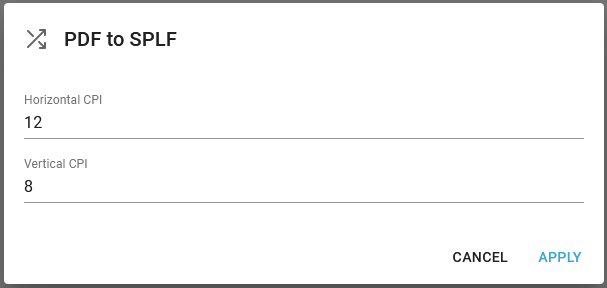IMPORTANT!! DO NOT use this feature in the 1.9.0 version, as an important change was made in the next version, which changed the behavior of existing definitions.
InterFormNG2 can extract text from a PDF file and put the extracted text into the special splf format as used in InterFormNG2. The workflow component, PDF to splf has several limitations and prerequisites, so testing is required in order to ensure, that it works with your PDF files. It is highly recommended to use this only for very simple PDF files preferably with a single, monospaced font.
You need a license code, that includes support for spooled files in order to use this component.
The PDF to splf component (which is a advanced converter component) has these parameters:

Horizontal CPI
The positions of texts in the input file can have a very flexible position and InterFormNG2 will map this into a fixed grid of lines and positions. This defines a horizontal grid size. If you e.g. selects 12 as the CPI, then the texts in the input PDF file are positioned in the output splf file based on 12 characters per inch. If e.g. a text is placed 0.5 inches from the left in the input file, then it will be placed in position 6 in the output splf file.
Vertical CPI
As for the horizontal position the vertical position of texts can also be freely defined in the input PDF file. This parameter however defines the number of lines per inch, that should be used, when placing texts in the input PDF file into the output splf file. If a text e.g. is placed 1.5 inches from the top in the input PDF file, then the text will be placed in line 12, if you have selected 8 as the vertical CPI (meaning 8 lines per inch).
You might need to experiment with different values for both parameters in order to get the best result. A recommendation is to set the horizontal characters per inch (CPI) to fit the largest number of characters per inch in the input PDF file - or higher. The same for the vertical lines per inch: This should equal to or larger than the highest number of lines per inch.
Remember that the required CPI and LPI are inversely proportional to the font size: The smaller font size selected the larger CPI and LPI should be selected.
Limitations and things to note
•Each text string are inserted as text strings into the splf at the closest char grid-position which corresponds to the horizontal and vertical CPI’s.
•If there already are characters in the splf line, then the new chars are inserted at the line below in the output splf file.
•This conversion is considered a component of last resort when all other options are exhausted and MIGHT work with an input PDF.
•Only non-rotated PDF documents are supported and the documents also need to have text as actual text with extractable characters inside the PDF.
•PDF documents that are encrypted or password protected might not work.
•Only text is extracted, meaning images, embedded documents etc. are ignored.
Recommended use
You can use the PDF to splf conversion e.g. to extract text information from a PDF and use the extracted splf file as input for a simple merge into e.g. print, email or PDF e.g. with the basic create document components.